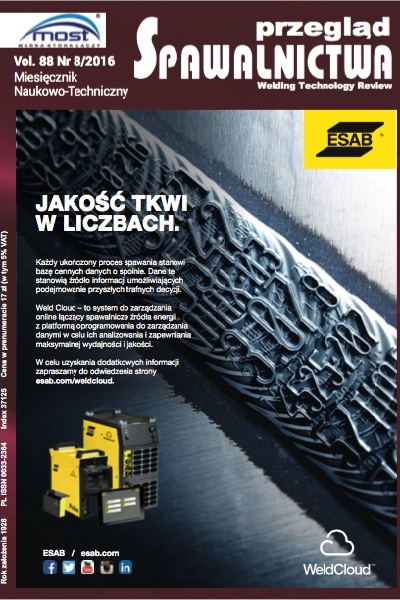Nowoczesne metody zgrzewania tarciowego punktowego materiałów konstrukcyjnych
Main Article Content
Abstract
W artykule przedstawiono aktualnie najpopularniejsze metody zgrzewania tarciowego punktowego. Obecnie łączenie metali lekkich jak stopy aluminium czy magnezu stwarza szereg problemów natury technologicznej czy metalurgicznej. Osiągnięcie odpowiednich właściwości wytrzymałościowych produkowanych złączy wymaga niejednokrotnie urządzeń o relatywnie wysokiej mocy, dodatkowych zabiegów obróbki cieplnej czy odpowiedniego przygotowania elementów łączonych. Ciekawą i coraz szerzej stosowaną alternatywą dla procesów zgrzewania rezystancyjnego punktowej jest zgrzewanie tarciowe punktowe. Jest to nowatorska metoda łączenia, powstała ona na bazie znanego procesu FSW (Friction Stir Welding) tj. zgrzewania tarciowego liniowego z wymieszaniem materiałów łączonych. Metoda FSW została ona opracowana przez Brytyjski ośrodek TWI (The Welding Institute) w 1991r a następnie rozwijana przez szereg ośrodków w USA, Japonii i Europie [1].
Abstract
The article presents the currently most popular methods of friction spot welding. Currently, joining of lightweight metals like aluminium and magnesium alloys poses a number of technological or metallurgical problems. Achieving the appropriate strength properties produced joints often requires devices with relatively high power, additional heat treat- ment and adequate preparation of the workpieces. Friction stir spot welding is an interesting and widely used alterna- tive processes for resistance spot welding. It is an innovative method of joining. It was founded on the basis of a well-known process of FSW (Friction Stir Welding). FSW method has been developed by the British Center TWI (The Welding Institute) in 1991 and then developed by a number of rese- arch centers in the US, Japan and Europe.
Downloads
Article Details
Creative Commons CC BY 4.0 https://creativecommons.org/licenses/by/4.0/
Welding Technology Review (WTR) articles are published open access under a CC BY licence (Creative Commons Attribution 4.0 International licence). The CC BY licence is the most open licence available and considered the industry 'gold standard' for open access; it is also preferred by many funders. This licence allows readers to copy and redistribute the material in any medium or format, and to alter, transform, or build upon the material, including for commercial use, providing the original author is credited.
References
A. Pietras, R. Bogucki, Rozwój technologii zgrzewania tarciowego z mieszaniem materiału uplastycznionego w strefie zgrzeiny, Szybkobieżne Pojazdy Gąsienicowe nr 1, Gliwice 2005.
A new method for light alloy joining Friction Spot Joining, Kawasaki Heavy Industries. http://pdf.directindustry.com/pdf/kawasaki-robotics/ fsj/18836-307065.html, 10.11.2015.
J. F. Hinrichs, C. B.Smith, B. F. Orsini, R. J. DeGeorge, B. J. Smale, P. C. Ruehl, Friction Stir Welding for the 21st Century Automotive Industry, Proceedings of the Fifth International Conference on Friction Stir Welding, Metz (France), 2004.
F. Boiocchi, Friction Stir Spot Welding Applied to TP AA6061-T4 sheet metals, Metalworking World Magazine, http://www.metalworkingworld- magazine.com, 7.04.2016.
T. Montag, J. P. Wulfsberg, H. Hameister, R. Marchner, Influence of Tool Wear on Quality Criteria for Refill Friction Stir Spot Welding (RFSSW) Process, New Production Technologies in Aerospace Industry - 5th Machining Innovations Conference, MIC, 2014.
L. C. Campanelli, U. F. H. Suhuddin, J. Fernandez dos Santos, N. Guedes de Alcântara, Parameters optimization for friction spot welding of AZ31 magnesium alloy by Taguchi method, Soldag. Insp. Vol. 17 no. 1, São Paulo, 2012.
